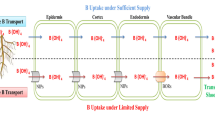Abstract
A greenhouse experiment was conducted to elucidate the growth changes and tissues anatomical characteristics of giant reed (Arundo donax L.), a perennial rhizomatous grass, which was cultivated for 70 d in soils contaminated with As, Cd and Pb. The results show that giant reed rapidly grows with big biomass of shoots in contaminated soil, possessing strong metal-tolerance with limited metal translocation from roots to shoots. When As, Cd and Pb concentrations in the soil are less than 254, 76.1 and 1 552 mg/kg, respectively, plant height and dried biomass are slightly reduced, the accumulation of As, Cd and Pb in shoots of giant reed is low while metal concentration in roots is high, and the anatomical characteristics of stem tissues are thick and homogeneous according to SEM images. However, plant height and dried biomass are significantly reduced and metal concentration in plant shoots and roots are significantly increased (P<0.05), the stems images become heterogeneous and the secretion in vascular bundles increases significantly when As, Cd and Pb concentrations in the soil exceed 334, 101 and 2 052 mg/kg, respectively. The giant reed is a promising, naturally occurring plant with strong metal-tolerance, which can be cultivated in soils contaminated with multiple metals for ecoremediation purposes.
Similar content being viewed by others
References
MCGRATH S P, LOMBI E, GRAY C W, CAILLE N, DUNHAM S J, ZHAO F J. Field evaluation of Cd and Zn phytoextraction potential by the hyperaccumulators Thlaspi caerulescens and Arabidopsis halleri [J]. Environmental Pollution, 2006, 141(1): 115–125.
CHARY N S, KAMALA C T, RAJ D S S. Assessing risk of heavy metals from consuming food grown on sewage irrigated soils and food chain transfer [J]. Ecotoxicology and Environmental Safety, 2008, 69(3): 513–524.
CUI Y J, ZHU Y G, ZHAI R H, CHEN D Y, HUANG Y Z, YI Q, LIANG J Z. Transfer of metals from soil to vegetables in an area near a smelter in Nanning, China [J]. Environment International, 2004, 30(6): 785–791.
WONG M H. Ecological restoration of mine degraded soils, with emphasis on metal contaminated soils [J]. Chemosphere, 2003, 50(6): 775–780.
WEI C Y, CHEN T B. Arsenic accumulation by two brake ferns growing on an arsenic mine and their potential in phytoremediation [J]. Chemosphere, 2006, 63(6): 1048–1053
TANHAN P, KRUATRACHUE M, POKETHITIYOOK P, CHAIYARAT R. Uptake and accumulation of cadmium, lead and zinc by Siam weed [Chromolaena odorata (L.) King & Robinson]_[J]. Chemosphere, 2007, 68(2): 323–329.
YE Z H, BAKER A J M, WONG M H, WILLIS A J. Zinc, lead and cadmium tolerance, uptake and accumulation by Typha latifolia [J]. New Phytologist, 1997, 136(3): 469–480.
YE Z H, BAKER A J M, WONG M H, WILLIS A J. Zinc, lead and cadmium tolerance, uptake and accumulation by the common reed, Phragmites australis (Cav.) Trin. ex Steudel [J]. Annals of Botany, 1997, 80(3): 363–370.
ANGELOVA V, IVANOVA R, DELIBALTOVA V. Bio-accumulation and distribution of heavy metals in fibre crops (flax, cotton and hemp) [J]. Industrial Crops and Products, 2004, 19(3): 197–205.
PAPAZOGLOU E G, KARANTOUNIAS G A, VEMMOS S N, BOURANIS D L. Photosynthesis and growth responses of giant reed (Arundo donax L.) to the heavy metals Cd and Ni [J]. Environment International, 2005, 31(2): 243–249.
PAPAZOGLOU E G. Arundo donax L. stress tolerance under irrigation with heavy metal aqueous solutions [J]. Desalination, 2007, 211(1/3): 304–313.
MIRZA N, MAHMOOD Q, PERVEZ A, AHMAD R, FAROOQ R, SHAH M M, AZIM M R. Phytoremediation potential of Arundo donax in arsenic-contaminated synthetic wastewater [J]. Bioresource Technology, 2010, 101(15): 5815–5819.
FISCHEROVÁ Z, TLUSTOŠ P, SZÁKOVÁ J, ŠICHOROVÁ K. A comparison of phytoremediation capability of selected plant species for given trace elements [J]. Environmental Pollution, 2006, 144(1): 93–100.
NASSO N N O D, ANGELINI L G, BONARI E. Influence of fertilization and harvest time on fuel quality of giant reed (Arundo donax L.) in central Italy [J]. European Journal of Agronomy, 2010, 32(3): 219–227.
VERVERIS C, GEORGHIOU K, CHRISTODOULAKIS N, SANTAS P, SANTAS R. Fiber dimensions, lignin and cellulose content of various plant materials and their suitability for paper production [J]. Industrial Crops and Products, 2004, 19(3): 245–254.
ABRANTES S, EMILIA M, COSTA A P, SHATALOV A A, DUARTE A P. Evaluation of giant reed as a raw-material for paper production [J]. Appita Journal, 2007, 60(5): 410–415.
BASSO M, CUKIERMAN A. Wastewater treatment by chemically activated carbons from giant reed: Effect of the activation atmosphere on properties and adsorptive behavior [J]. Separation Science and Technology, 2006, 41(1): 149–165.
MAVROGIANOPOULOS G, VOGLI V, KYRITSIS S. Use of waste water as a nutrient solution in a closed gravel hydroponic culture of giant reed (Arundo donax) [J]. Bioresource Technology, 2002, 82(2): 103–107.
STOLTZ E, GREGER M. Accumulation properties of As, Cd, Cu, Pb and Zn by four wetland plant species growing on submerged mine tailings [J]. Environmental and Experimental Botany, 2002, 47(3): 271–280.
LU Ru-kun. Analytical methods of soil agricultural chemistry [M]. Beijing: Agriculture Science and Technology Press of China, 1999: 1–227. (in Chinese)
TAKAHASHI-IWANAGA H. Comparative anatomy of the podocyte: A scanning electron microscopic study [J]. Microscopy Research and Technique, 2002, 57(4): 196–202.
LEI M, CHEN T B, HUANG Z C, WANG Y D, HUANG Y Y. Simultaneous compartmentalization of lead and arsenic in co-hyperaccumulator Viola principis H. de Boiss.: An application of SRXRF microprobe [J]. Chemosphere, 2008, 72(10): 1491–1496.
KOLESIK P, MILLS A, SEDGLEY M. Anatomical characteristics affecting the musical performance of clarinet reeds made from Arundo donax L. (Gramineae) [J]. Annals of Botany, 1998, 81(1): 151–155.
Author information
Authors and Affiliations
Corresponding author
Additional information
Foundation item: Project(20507022) supported by the National Natural Science Foundation of China
Rights and permissions
About this article
Cite this article
Guo, Zh., Miao, Xf. Growth changes and tissues anatomical characteristics of giant reed (Arundo donax L.) in soil contaminated with arsenic, cadmium and lead. J. Cent. South Univ. Technol. 17, 770–777 (2010). https://doi.org/10.1007/s11771-010-0555-8
Received:
Accepted:
Published:
Issue Date:
DOI: https://doi.org/10.1007/s11771-010-0555-8




